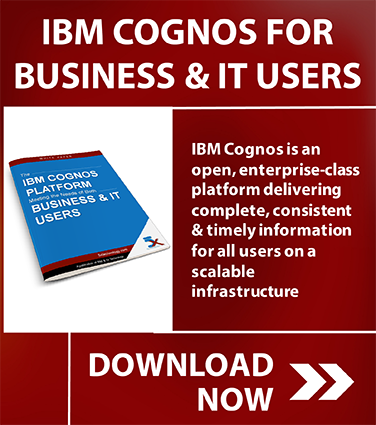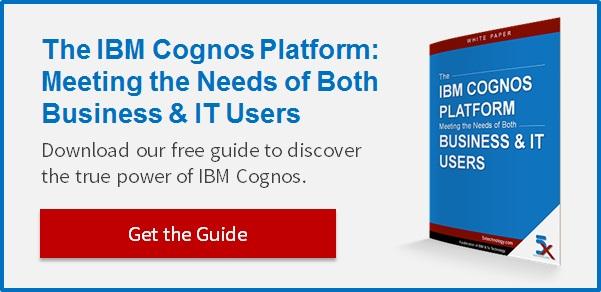Data is a precious commodity for businesses of all sizes. However, as a company grows, accessing, organizing, and analyzing all that data becomes increasingly more difficult.
To get the most out of data, a business has to define its BI goals and determine the best business intelligence process for reaching those goals.
Fortunately, there are BI dashboard tools, like IBM Cognos, that can help you use your data smarter by adhering to a set BI dashboard best practices. The ease of use and five-step implementation process make this product one for serious consideration.
How To Define Your Business Intelligence Goals
The business intelligence process is a set of approaches for gathering, storing, analyzing and sharing data. Although the specific goals will vary depending upon the enterprise, it is important to first define your needs before creating any analysis process.
With the end goals in mind, you can create the best BI process for your organization.
Some of the most common goals include the following:
- Increasing profits
- Budgeting and forecasting for scale and growth
- Analyzing trends and consumer buying patterns
- Measuring, tracking and predicting sales
- Tracking the performance of marketing campaigns
- Streamlining processes and improving operational performance
- Improving delivery and supply chain effectiveness
- Effective asset management and protection
- Internet, social, and e-commerce data analytics
- CRM and CEM metrics
- Advanced reporting capabilities
Once you have identified your goals you can begin to define your approach and determine what type of data to gather. For some scenarios, it is beneficial to gather as much data from as many different sources as possible, for other scenarios you may find it is best to focus on a particular geographic area or single data source.
Don't forget: When determining your approach, it is important to use best practices as your guiding light.
6 Best Practices For A Solid Business Intelligence Dashboard
- Design the dashboard for a particular purpose. Decide whether it is to be used for operational or analytical purposes?
- Ensure data consistency and quality. Poor and inconsistent data quality could blindside your organization's BI process.
- Focus on a single subject area per tab. Tabs keep data sets organized and separate. Crosstabs search features allow you to search and combine multiple tabs.
- Plan & know your audience. Every department will have different needs and require unique data sets.
- Ensure interactivity. Allow users to drill deeper and/or sort information. Focus on specific information with a single click of your mouse.
- Keep it simple! Clear & readable data on a single page is best. A well-designed BI dashboard is a visual display of the most relevant information that can be monitored at a glance.
How IBM Cognos Facilitates Best BI Practices
Research continues to indicate that poor data quality is one of the most common problems with modern data analysis processes. This can be avoided altogether with the quality control solutions which enable you to clean, manage, and make available the most reliable and relevant information across your entire organization.
For those without a business intelligence process, data is one of the most critically underutilized assets. To be competitive and grow, you need to have the ability to access, manage and interact with your valuable business data whenever and wherever you want, ideally using a single piece of software that easily integrates into existing systems.
As you search for the right BI dashboard product, you will find that while there are many options available, not all are created equal. Each product differentiates in a unique way, while only a small handful are excellent all around choices. IBM Cognos is one of the better all around business intelligence dashboard solutions on the market today.
One feature that sets IBM Cognos apart from other BI soliutions is ease of use. The popular Cognos' Studios feature allows users to create visually stunning customized dashboards with point and click ease. Since each business segment has unique needs, it is unneccessary to waste valuable time and resources filtering through a display filled with extraneous information that is meaningless to your operational goals.
Streamlining access to useful data ensures adoptibility and usability across a wide variety of organizations within your business. With Cognos, to create a new and separate dashboard, you simply assemble the tabbed data by using the Multi-page portlet within the design studio, which allows for various segments of data to be displayed on different tabs.
Many features built into Cognos allow you to interact with your data in a variety of ways. The ability to search all indexed data by conducting a full content search allows the user to make discoveries of previously hidden connections, drill down into data to reveal the most accurate data regarding locations, assets, and sales history, or sort through multiple verticals simultaneously.
With this software you can perform scenario testing with variables, or create an interactive scorecard diagram based on new or existing data, allowing you to better plan and forecast for growth and scale. Scorecards can easily be built for different audiences that cover customized levels of detail. To better manage your scorecard, it is a best practice to create separate visualizations for each department in your organization, which is easily accomplished when utilizing this software.
Above all, IBM Cognos allows you to easily create a visually attractive dashboard display that frequently and accurately updates, giving you instant access to all of your essential and relevant data on a single page.
Implementing IBM Cognos In 5 Easy Steps
Whether you are implementing a business dashboard for the very first time or transitioning from another BI tool, there are five simple steps to deploy Cognos business intelligence.
- Analyze - Define what your business intelligence process solution needs to accomplish. Consider the required features as well as the non-functional attributes such as performance and ease of use. During this phase, discuss requirements of the end users, conduct project scoping and perform IT readiness assessments including infrastructure requirements. Prepare policy and procedure relative to training plans, validation, and verification.
- Design - Begin by identifying all components and any dependencies. Plan your installation in a development environment and undertake system design activities including prototyping, making sure to verify all data sources and migration requirements. This phase will conclude with installation, configuration, training, validation and verification.
- Build - This phase is where the system is constructed. Application configuration will take place and interfaces are created. Security infrastructure and licensing rights are implemented. Migration from development environment to a QA environment is a necessary stop to carry out system performance and UAT testing.
- Deploy - You will now implement the deployment plan, running applications and establishing support and maintenance schedules. Conduct readiness testing and migrate the app to the production environment. Finalize all user agreements and documentation. Now the application is ready for launch. Training plans should begin.
- Operate - You are now ready to effectively utilize the Cognos BI Dashboard and all installed applications and features. From here you will monitor, manage and maintain the system per your schedule of routine performance and quality control activities.
This five-step process can be completed by your own in-house team, or with the support and experience of 5x Technology. We can oversee and manage the entire process, or perhaps assist with a particular phase; such as the initial review —determining which BI software is best suited for your unique business needs. We are here to help with any combination of these services, including training.
Regardless of which software tool you're looking to take advantage of (reporting, dashboard design, etc.), we have the experience you need to utilize your information in the most efficient and cost-effective way possible.






